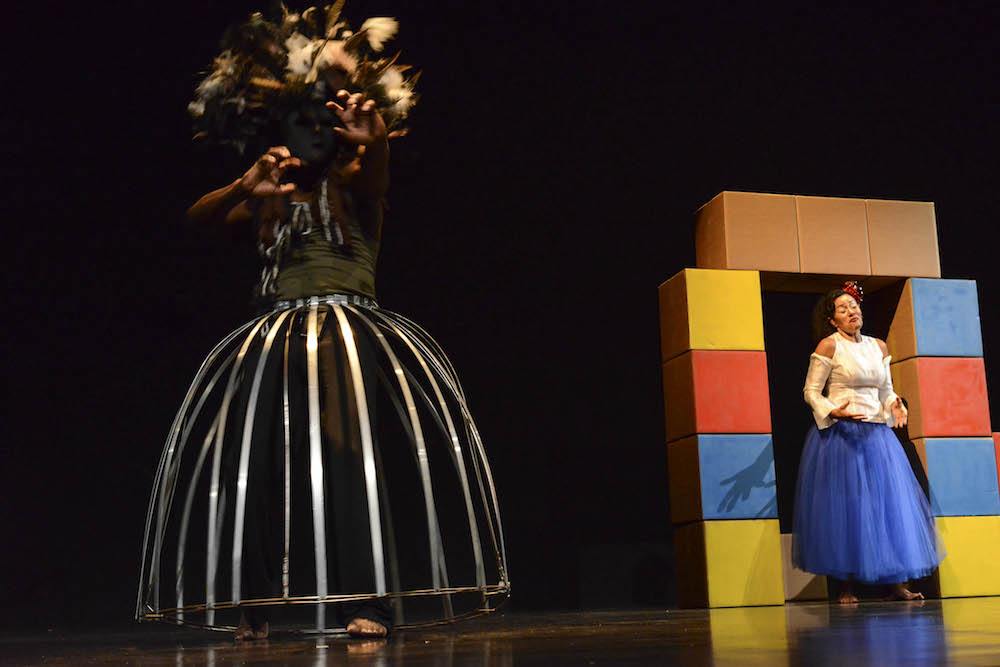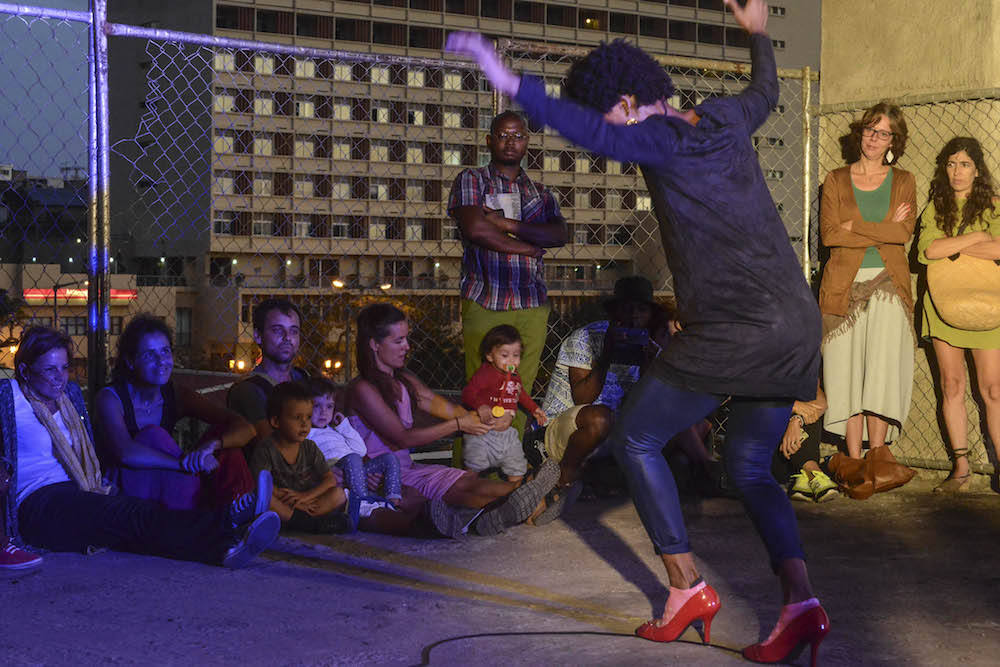It was strangely fitting that a work such as Panaibra Canda’s (Un)Official Language would come to be so symbolic of this year’s edition of the Danse l’Afrique danse! festival. The festival, cohosted with the Maputo-based Kinani dance biennale, took place from October 16 to 20 in several venues around Maputo’s city centre.
Canda’s work explored the tensions between the mother tongue and the colonial language while, through its unintended foibles, the work became a metaphor for the politics of collaboration – a theme hovering through this biennale.
Canda, a prominent Mozambican contemporary dance choreographer, who formed part of the country’s first wave of contemporary dancers, was an artistic director of the festival.
For his piece he worked with two artists, Portuguese jazz singer Maria João and Mozambican dancer Leia Mabasso. The result was a musical, academic and humorous look at the truncated dual identities produced, in particular, by the Mozambican (post)colonial experience.
In person, Canda comes across as a quietly spoken intellectual and on stage as an understated yet profound dancer. João, with her commanding presence and strong voice, however, diverted some attention away from him. Mabasso, despite the finesse of her movements, was constrained by the constantly occupied stage.
Though highly resonant, the piece, produced as part of the Pamoja programme that links different parts of the continent through residencies, came to symbolise the difficult dynamics of the collaborative process that produced it – and, in doing so, held a mirror up to the entire festival.
Canda says this year’s Kinani event involved putting a certain amount of trust into the coprogramming with Danse l’Afrique danse!, as some of the works shown were still in the process of creation. “So with this edition we were expecting surprises,” said Canda.
This iteration of Kinani served as a regional stop to see Danse l’Afrique works produced in residency before this pan-African dance event moves to Burkina Faso next year, where it will be hosted in conjunction with the Dialogue de Corps festival in Ouagadougou.

Panaibra Canda and Maria Jõao in (Un)Official Language. (Adiodato Gomes)
About 25 works were staged, with two primary venues being used – the Teatro Avenida and the French-Mozambican Cultural Centre, which has two auditoriums. On occasion, alternative venues were used, such as the iconic skeletal building on July 24th Avenue for the 4°?Andar government-sponsored programme and the Museu de Pescas (Museum of Fisheries) on the opening and closing days.
Young movers and shakers
As this was a festival hosted by a Mozambican dance platform, it is perhaps fitting to look at some of the experimental works being staged at 4°?Andar, which were produced largely by local artists. The architecture of the space, spread over four floors, compelled the audience to engage with the work intimately.
Domingos Bié’s Politicamente Falando was probably the most politically charged work of the festival. He began by stripping down to his underwear, a tie and some brogues. He stepped on a tomato at the edge of his stage, its juices splattering on the pants of some his audience. Bié later knelt sideways on a wooden chair, mouth open but mute, as he supported himself on alternate arms while switching between wide-mouthed, black power and military salutes. He went on to stand on the very same chair, gorging on an apple and letting the juices and pulp dribble down his chin while executing a variety of salutes.
If Bié was communicating a fatigue for post-colonial avarice, then his message – as his mouth became the proverbial trough – rang out loud and clear.
On another floor, his compatriot Janeth Mulapha explored “what it was in my body that makes me a woman”, using what would become a recurring motif at this festival: a pair of red high heels.
In the piece, titled My Gender Lives Here, which she presented in Kisangani earlier this year as part of the Pamoja residency initiative, Mulapha tried to balance on a circuitous microphone cord lying on the ground.
She later donned the red heels and took one off before grinding its heel flat to the ground. In trying to limp her way out of her gendered pigeonhole, she mocked the standards of beauty she was expected to adhere to. Her performance, quirky and committed, signalled her as another choreographer to watch.
The work 5 Sense Organs saw Mulapha in the role of main choreographer, this time supported by Bié, Pak Ndjamena and Bongiwe Dlamini, a gifted singer. By staging the piece last, the festival curators seemed to suggest that it wanted its audience to think it over.

Janeth Mulapha in her performance of My Gender Lives Here. (Adiodato Gomes)
The work was intensely physical and unflinching, showing that creative and constant interplay between dancers on stage is something that’s quite easily feasible.
Perhaps the festival’s standout piece belonged to Studios Kabako dancer Jeannot Kumbonyeki’s solo, yet interactive work, Le Kombi. Using his body to question the place of the artist in the Democratic Republic of Congo, Kumbonyeki employed two benches and an offstage video clip to integrate an experience we all knew well: a bumpy, precarious taxi ride.
Kumbonyeki was essentially krumping, but broke through the limits of his form by being true to his narrative. He also displayed loads of charisma by seamlessly weaving from the personal to the public as he got the audience to participate in his bumpy ride through life, standing on the edge of a bench and “hailing passengers”.
The grand scale and emotional intensity of South African dancer-choreographers Nelisiwe Xaba and Mamela Nyamza’s The Last Attitude, the risqué poetry of Malagasy Judith Manantenasoa’s Métamorphose and the raw, work-in-progress intricacy of her compatriot Gaby Saranouffi’s Lady Lady, My Gender Power, point to some of the festival’s programmatic risks and successes.
No country is an island
Depending on who you ask, the Francophone bent that comes with Institut Français’s support and a shared programme may have diluted the Mozambican national imperative, but the wider focus may just trigger a further shift in the progress of the country’s dance scene.
According to Maria Helena Pinto, a dancer from the pivotal mid-1990s generation of contemporary dancers and the author of a new book on Mozambique’s contemporary dance history: “Danse l’Afrique danse! is a good moment to shake [up] Mozambican dancers and make them go forward in their exchanges and in the creation of new propositions. Being in front of the other – that also defines how this contemporary movement began [in Mozambique].”
Quito Tembe, the festival’s production director, said that in order to stage a festival like this in Mozambique, “it has to be really strong in terms of partners and funding. The really hard job is to prepare to get more partners involved.
“And I’m not just talking funders and money. The most important collaborations are our partnerships with theatres, technicians, the spaces where we meet – just involving the local arts scene as much as possible.”
On its relation to the dance scene in Africa, Tembe said: “We are lucky to have a lot of collaborations and stuff, but they are not happening expressly for this [festival]. We were lucky in that when we started programming a lot of the propositions were collaborations and for me the pieces reveal African discourse and tell us something about the way that Africans see Africa.”